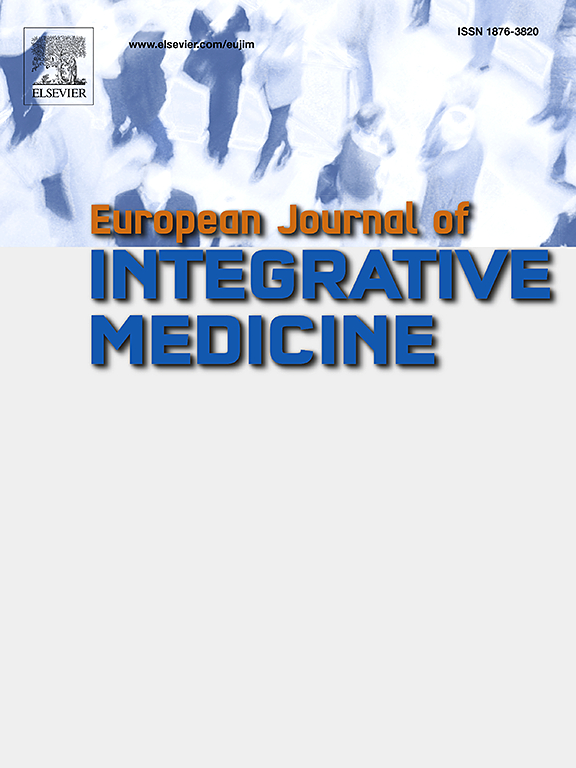Phytochemical profiling of Prunus armeniaca kernel extracts and exploration of their multifaceted antioxidant and antibacterial effects through in vitro and in silico studies
IF 1.9
4区 医学
Q3 INTEGRATIVE & COMPLEMENTARY MEDICINE
引用次数: 0
Abstract
Introduction
Prunus armeniaca "Apricot" kernels are considered a by-product widely employed in traditional medicine for treating various ailments due to their potential therapeutic properties. The current investigation sought to assess the properties of aqueous and methanol extracts of Prunus armeniaca kernels (PAK).
Methods
The phytochemical composition of the studied extracts was evaluated using high-performance liquid chromatography with a diode array detector (HPLC-DAD). Total antioxidant capacity (TAC), β-carotene bleaching, reducing power (RP), and 2,2-Diphenyl-1-picrylhydrazyl (DPPH) free radical scavenging assays were used to assess antioxidant activity. Using the disc diffusion method and the microdilution test in 96-well microplates against four bacterial strains, the antimicrobial activity of the aforementioned extracts was evaluated. The potential of several phenolic compounds as bacterial inhibitors was assessed through extensive density functional theory (DFT) calculations and molecular docking analyses.
Results
The phytochemical analysis revealed the identification of several phenolic constituents, with tocopherol (11.61 ± 0.9 mg/g of dry extract) and resveratrol (25.3 ± 0.4 mg/g of dry extract) emerging as the major compounds in the aqueous and methanolic extracts, respectively. Both extracts exhibited remarkable antioxidant activity with IC₅₀ values of 1.47 ± 0.08 and 1.97 ± 0.15 mg/mL (DPPH), EC₅₀ = 3.682 ± 0.123 and 12.415 ± 0.344 mg/mL (RP), TAC values of 6.486 ± 0.275 and 5.323 ± 0.826 mg AAE/g, and β-carotene values of 56 ± 0.553 % and 50 ± 0.645 % respectively. Moreover, the aqueous extract showed the highest antibacterial activity against Staphylococcus aureus with a MIC value of 0.625 mg/mL, and an inhibition zone diameter of 11.5 ± 0.71 mm. The combined analysis of docking results and DFT calculations for various phenolic compounds against Staphylococcus aureus (Glycyl-penicillin-binding protein 2a) and Escherichia coli (DNA Gyrase B) revealed significant interactions and reactivities.
Conclusion
These results clearly indicate that PAK contains a high concentration of bioactive compounds, especially tocopherol and resveratrol, and may serve in the treatment of various diseases thanks to its extracts' promising antioxidant and antimicrobial activities.
亚美尼亚李核提取物的植物化学特征及其体外和体外抗氧化和抗菌作用的探索
亚美尼亚prunus armeniaca“杏”核被认为是一种副产品,由于其潜在的治疗特性,被广泛应用于传统医学中治疗各种疾病。本研究旨在评价亚美尼亚李(Prunus armeniaca)仁(PAK)的水提物和甲醇提物的性质。方法采用高效液相色谱二极管阵列检测器(HPLC-DAD)对所研究提取物的植物化学成分进行鉴定。用总抗氧化能力(TAC)、β-胡萝卜素漂白、还原能力(RP)和2,2-二苯基-1-苦味肼基(DPPH)自由基清除试验来评估抗氧化活性。采用圆盘扩散法和96孔微孔板微量稀释试验对4种细菌进行抑菌活性评价。通过广泛的密度泛函理论(DFT)计算和分子对接分析,评估了几种酚类化合物作为细菌抑制剂的潜力。结果经植物化学分析,鉴定出多种酚类成分,其中水提物和甲醇提物的主要成分分别为生育酚(11.61±0.9 mg/g)和白藜芦醇(25.3±0.4 mg/g)。两种提取物都具有显着的抗氧化活性,IC₅₀值为1.47±0.08和1.97±0.15 mg/mL (DPPH), EC₅₀值为3.682±0.123和12.415±0.344 mg/mL (RP), TAC值为6.486±0.275和5.323±0.826 mg AAE/g, β-胡萝卜素值分别为56±0.553 %和50±0.645 %。水提物对金黄色葡萄球菌的抑菌活性最高,MIC值为0.625 mg/mL,抑菌带直径为11.5±0.71 mm。结合对接结果分析和DFT计算,多种酚类化合物对金黄色葡萄球菌(Glycyl-penicillin-binding protein 2a)和大肠杆菌(Escherichia coli, DNA Gyrase B)具有显著的相互作用和反应性。结论白芷提取物中含有高浓度的生物活性物质,特别是生育酚和白藜芦醇,具有良好的抗氧化和抗菌活性,可用于多种疾病的治疗。
本文章由计算机程序翻译,如有差异,请以英文原文为准。
求助全文
约1分钟内获得全文
求助全文
来源期刊

European Journal of Integrative Medicine
INTEGRATIVE & COMPLEMENTARY MEDICINE-
CiteScore
4.70
自引率
4.00%
发文量
102
审稿时长
33 days
期刊介绍:
The European Journal of Integrative Medicine (EuJIM) considers manuscripts from a wide range of complementary and integrative health care disciplines, with a particular focus on whole systems approaches, public health, self management and traditional medical systems. The journal strives to connect conventional medicine and evidence based complementary medicine. We encourage submissions reporting research with relevance for integrative clinical practice and interprofessional education.
EuJIM aims to be of interest to both conventional and integrative audiences, including healthcare practitioners, researchers, health care organisations, educationalists, and all those who seek objective and critical information on integrative medicine. To achieve this aim EuJIM provides an innovative international and interdisciplinary platform linking researchers and clinicians.
The journal focuses primarily on original research articles including systematic reviews, randomized controlled trials, other clinical studies, qualitative, observational and epidemiological studies. In addition we welcome short reviews, opinion articles and contributions relating to health services and policy, health economics and psychology.
 求助内容:
求助内容: 应助结果提醒方式:
应助结果提醒方式:


